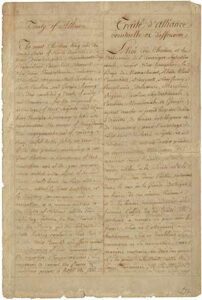The French Revolution
The French Revolution provides an important illustration of a revolution gone wrong. Its temporal association with the American Revolution invites a comparison between the two. Both were in civilized countries with advanced concepts of social justice founded in concepts of equality and the rights of the common man.
By any objective measure, the French Revolution went terribly wrong. It led to the death of hundreds of thousands of innocent French citizens even though it started attempting to provide a more just society. The carnage wrought by the Revolution did not stop in France but spread throughout Europe when Napoleon became ruler of France. His totalitarian militaristic government tried to conquer Europe through a series of wars bringing death and devastation to millions. The Napoleonic Wars eventually led to the return of the French monarchy and a century of unstable governments and lost opportunities.
The Best of Times
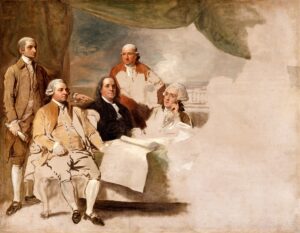
Signing of the Treaty of Paris. The British signers refused to pose and the painting was never finished. Public Domain, Link
The history of the French Revolution starts in America which was involved in a fierce conflict with Britain for its independence. The nascent American government had declared independence from Britain but became involved in a nearly hopeless war with far greater power. America lost battle after battle with England, and the cause of independence seemed certain to fail. Many of the volunteer soldiers in Washington’s army were deserting, Congress was underfunding the war effort, and international support was lagging.
England and France had been at each other’s throats for centuries and had fought a proxy war in America for decades. King Louis XVI of France sensed the time had come to help the Americans desperate fight against the British and defeat a common enemy.The French and English had been busy fighting each other in a long series of conflicts in what is now western Pennsylvania. The British eventually secured the western territories as France lost most major battles. France was eager to inflict revenge on Britain for their losses – and found an unlikely ally in the emerging American independence movement.
France had been helping America covertly by providing supplies to the Continental Army such as gunpowder and cannons. The Treaty of Alliance between France and America was inked in 1778 making France an official military ally of the young country. The French did no seriously engage in the cause of American independence until it seemed possible the Americans might actually overthrow their British oppressors.
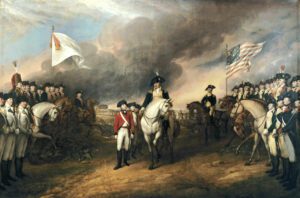
Surrender of the British at Yorktown – By John Trumbull – http://www.aoc.gov/cc/photo-gallery/ptgs_rotunda.cfm, Public Domain, Link
The French seized their opportunity to defeat the British by providing naval support during the Battle of Yorktown in 1781. The French naval blockade kept the British from reinforcing their beleaguered army and enabled the Americans to achieve a decisive victory.
The defeat of a much superior British Army provided a significant morale boost for Washington’s troops and led to the signing of the Treaty of Paris in 1783 formally ending the Revolutionary War.
It was the best of times for the young American nation as they eventually secured their independence from Britain and were able to start developing a nation based on the God-given rights of man. The Declaration of Independence proposed the country be founded on these principles,
We hold these truths to be self-evident, that all men are created equal, that they are endowed by their Creator with certain unalienable rights, that among these are Life, Liberty and the Pursuit of happiness.
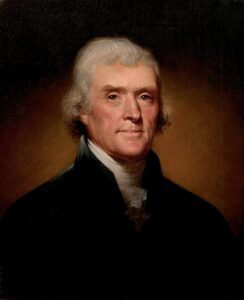
Thomas Jefferson – the primary author of the Declaration of Independence – Public Domain, Link
The Constitution and the Bill of Rights eventually codified these rights considered to be “unalienable” and God-given – not derived from the will of the state or by any “social contract” that might be limited by a tyrannical government.
Over the next several decades, America would be enveloped in the Second Great Awakening – a time of national spiritual rebirth. America was founded on the Biblical notion of the inherent wickedness present in every person and the need for separation of powers. The Founding Fathers understood that power is best concentrated closer to people, so that “We The People” fun the government.
Another revolution across the Atlantic would come to different conclusions and would concentrate power in the hands of a central government. This centralization of power would enable a tyrannical government to engage in wars against not only its own citizens but also those of other nations leading to the death of millions.
The Worst of Times
While America celebrated its defeat of British tyranny with the formation of a new government, things were not going as well in France.
The young French king Louis XVI had succeeded in defeating his old British nemesis in America, but the cost was high. France gained very little from the victory other than a morale boost and tremendous debt.
The French government was on the verge of financial collapse due to multiple factors. The long wars with England, expensive bureaucracy, self-entitled nobility, and an inefficient tax structure produced severe financial adversity. The Minister for Finance, Charles de Calonne, informed the King that the government was on the verge of bankruptcy on August 209th, 1786.
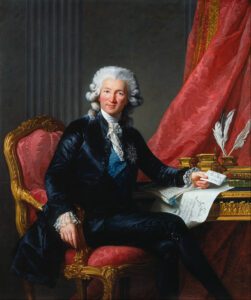
Calonne – By Élisabeth Louise Vigée Le Brun – cQGHDF7RxrnPWQ at Google Cultural Institute maximum zoom level, Public Domain, Link
Calonne has his work cut out for him. He was worried about civil unrest should he try to raise money by further taxing the peasants, but was also reluctant to ask nobles for money. He approached various European banks for loans but by that time, the depth of France’s financial crisis was common knowledge and loans were not forthcoming.
A council of nobles was convened by Calonne to convince them to pay more taxes to prevent financial collapse. Not surprisingly, the meeting ended in failure.
Ultimately, Calonne was not successful in convincing the King, nobles, or regional governments to increase taxes or reduce expenses and was fired by the King. The resentment felt by the peasants regarding the inability of the King and nobles to control their spending led to further resentment. Queen Marie Antoinette was referred to as Madame Deficit for her part in the lavish spending and elegant living in the Palace of Versailles. It seemed beyond belief to the entrenched aristocracy that the privileged status of royal France might be challenged by mere peasants.
The Estates
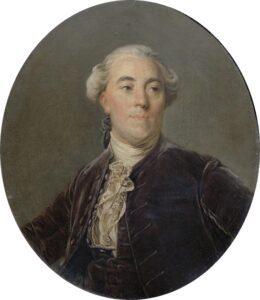
Neckler – By After Joseph Duplessis – Unknown source, Public Domain, Link
After the dismissal of Calonne, the King appointed Jacques Necker who had previously served the King as director of finances. Necker convinced the King to assemble the Estates-General – a French congress that originated in medieval times consisting of three “estates.” The First Estate consisted of clergy, the Second Estate represented the nobility, and the Third Estate was everybody else.
Another rendering of the three estate partitioning of government in France was a group that prayed, a group that fought, and a group that worked. The partitioning ensured power would be kept with the nobility with little power possessed by the French people.
The first and second estates of the clergy and nobility were treated the same and received similar privileges and tended to vote the same way. This kept the third estate locked out of any power thereby ensuring they continued to be powerless. This system resulted in resentment among peasants as they were unable to realize any societal privileges.
France was becoming increasingly secularized as peasants resented the privileged status of the clergy. They also resented the flagrant lifestyle of the nobles who essentially did nothing but live off the taxes extracted from the peasants, while the peasants had to scrounge for their daily bread.
Fed up with their mistreatment and under-representation, the Third Estate developed activists and pamphleteers who to took to the streets in protest. Perhaps the most famous of these writers was Emmanuel-Joseph Sieyes. He wrote, “What is the Third Estate?” articulating the feeling in France that a small minority is in control of the country, while the country truly belonged to the masses.
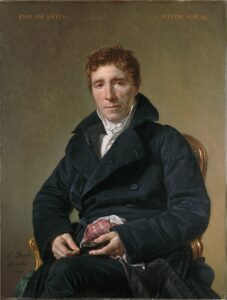
Sieyes – Public Domain, Link
As a result of these developments, the Third Estate rebelled from the Estates-General and formed itself into the National Constituent Assembly on June 17, 1789. This Assembly granted itself the power of taxation; many members of the other estates also joined their cause believing the peasants were being treated unfairly.
Storming the Bastille
The Bastille was a prison located in the center of Paris which was stormed by anarchists on July 14, 1789. The Fortress had been a police prison holding mostly political prisoners. The King did not forcibly respond against the mob invading his prison as he wanted to appease the mob and appear “enlightened”. His appeasement failed to achieve the desired result enabling the rioters to overrun the prison and slaughter many guards. The rioters also acquired a large number of armaments which they put to good use later.
The Storming of the Bastille encouraged the French nobility to reconsider their opposition to the rights of peasants. The King’s Court and deputies of the National Constituent Assembly met at the Palace of Versailles in order to discuss possible reforms to placate the growing revolutionary spirit of the population. These included the revolutionary August Decrees which totally abolished most noble and clerical privileges and the Declaration of the Rights of Man and of the Citizen.
The National Constituent Assembly was unable to agree upon a new French constitution which would limit the power of the King. The King, however, was not in agreement with much of the work done by the Assembly. On September 18, 1789, he issued a formal statement giving approval to only a portion of the decrees – the deputies were frustrated. The King even stated he had serious reservations concerning the Declaration of the Rights of Man.
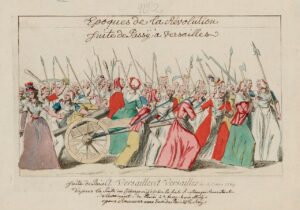
The Women’s March – By Unknown author – This image comes from Gallica Digital Library and is available under the digital ID btv1b8410839z/f1, Public Domain, Link
The “Women’s March on Versailles” began as a peaceful protest against food shortages, starting at the marketplaces in Paris on October 5. The demonstrators became intertwined with revolutionaries seeking a constitutional monarchy and various political reforms.
The unruly mob became violent and eventually grew to thousands. They ransacked the city armory for weapons and then marched to the Palace of Versailles. In a dramatic confrontation with the King, they pressed their demands for improvements in the social status of the underclass.
The mob surrounded the Palace demanding various reforms and becoming more violent. The crowd was particularly antagonistic toward the Queen and called for her execution. The Marquis de Lafayette – who had helped the Americans defeat the British in their war of independence – tried in vain to moderate the mob. The rioters were able to find an unguarded entrance to the Palace and rushed in to confront the rulers of France.
The crowd confronted the National Assembly meeting there and issued their demands. Several of the deputies there able to pacify the crowd somewhat including Mirabeau – a popular reformist, and Maximilian Robespierre who would become intimately involved in the eventual revolution.
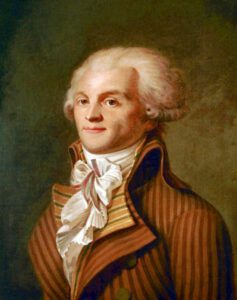
Robespiere – By Unknown author (French art) – www.paris.fr/portail/Culture, Public Domain, https://commons.wikimedia.org/w/index.php?curid=187181
The mob was pacified when the Assembly allowed a group is six representative women nominated by the crowd to be taken to see the King. The meeting went remarkably well with the King agreeing to disburse some food from the royal stores as well as agreeing to other demands. It started to rain heavily and the mob declared victory and left the Palace feeling their goals were met.
However, some of the crowd was not satisfied and stayed behind at the Palace. The King recognized the large crowd that refused to leave and tried to satisfy their demands by accepting the Declaration of the Rights of Man without qualification. This did little to quiet the tired mob who waited until the next day to make its move.
The protesters made their way inside the palace and searched for the Queen’s bed-chamber. The royal guards raced through the Palace trying to barricade hallways while the Queen ran barefoot to the King’s bed-chamber. The royal family was saved from likely death through the intervention of Lafayette and were escorted by a huge crowd out of the Palace to be relocated at the dilapidated Tuileries Palace. The National Assembly followed the royal family into their new residence at Tuileries.
The new Palace became a prison as much as a royal residence. The King was not permitted to travel and the country became further inflamed by a passion for fundamental transformation. On June 20, 1791, the Royal family tried to escape France recognizing the deteriorating condition of their status among the French people. They took a carriage at night and almost made it out of France when they were recognized from the King’s face being on a note of French currency. The entire family was brought back to the Tuileries to await their fate.
They would not have to wait too long. The Tuileries were stormed by a mob on August 10, 1792, with hundreds of Swiss Guards slaughtered trying to defend the King. The royal family fled across the Tuileries Gardens and took refuge with the National Assembly. One month later, the absolute monarchy was abolished and the First French Republic proclaimed by the Assembly on September 21, 1792.
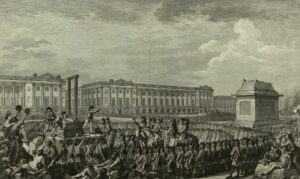
Execution of Louis XVI – By Isidore Stanislas Helman – Bibliothèque nationale de France, Public Domain, https://commons.wikimedia.org/w/index.php?curid=17446087
The National Convention – a self-proclaimed tribunal assembled for just for this occasion – found the King guilty of high treason and he was executed on January 21, 1793, as an ordinary French citizen Louis Capet. The revolutionaries assumed his last name would be that of Hugh Capet – the founder of the Capetian dynasty.
This brought to end the more than a thousand-year French monarchy. Both of his sons died in childhood before the monarchy was re-established in the Bourbon Restoration several years later.
The Reign of Terror
The government of France then fell to multiple groups of French revolutionaries with a race to become the most radical.
The motto of the French Revolution was “liberté, égalité, fraternité” meaning liberty, equality, and fraternity. This “correct” interpretation of this motto depended upon which faction was in power as “liberty” is experienced individually while “fraternity” is experienced collectively.
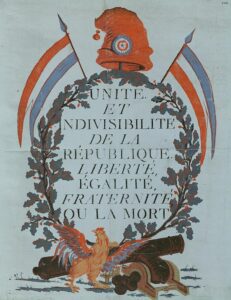
By Unknown author – http://gallica.bnf.fr/ark:/12148/btv1b69503876.r=Unit%C3%A9+indivisibilit%C3%A9+de+la+R%C3%A9publique.langFR, Public Domain, https://commons.wikimedia.org/w/index.php?curid=30577458
The French Revolution interpreted liberty in the context of fraternity. The French “fraternity” or brotherhood demanded the surrendering of an individual’s liberty to the “general will” of the state, with the state determining how much “liberty” can be granted to the individual.
There was no concept of the “inalienable rights” God-given rights of the individual expressed in the American Declaration of Independence. In France, there were no “intrinsic” rights of people; rights that belonged to people by their very nature of being.
The French understanding of fraternity is that the greater good of the fraternity demands the surrender of individual rights as needed. The fraternity can forcibly take possessions away from those who might be not favored politically, or who the ruling class thinks have too much – accusing them of being selfish and redistributing the possessions to its supporters.
Maximilian Robespierre was a master politician who we met before as a member of the National Assembly. After the King’s execution, Robespierre became head of the paradoxically named “Committee of Public Safety.” Robespierre believed terror was needed to reshape the population of France into his vision of the way government should be structured,
Robespierre gave a speech to the National Assembly on February 5, 1794, titled “The Terror Justified,”
Lead … the enemies of the people by terror … Terror is nothing else than swift, severe, indomitable justice.
Historians have agreed that “terror” was the essential part of the Reign of Terror put in place by the French leaders. In “Citizens: A Chronicle of the French Revolution”, historian Simon Shama notes,
The terror … was not just an unfortunate side effect … it was the Revolution’s source of collective energy … From the very beginning, violence was the motor of the revolution.
The “enemies of the state” kept increasing as the Reign of Terror progressed. Robespierre began accusing, arresting, and beheading:
- First the royalty,
- Then the wealthy,
- Then the farmers and businessmen,
- Then came those hoarding food,
- Next came the religious clergy,
- Then the former revolutionaries (who were not revolutionary enough)
The Revolution ended up beheading about 40,000 in Paris alone.
Historian Don Feder noted,
Slaughter in the name of the ‘people,’ atheism, thought police, the ruthless suppression of dissent, mass murder for ideological purity, – all started in the orgy of murder and nihilism unleashed by the furies of Jacobinism.
They started by killing aristocrats and royalists, then moderates (like the Girondists), then dissidents, then any who had doubts, until, finally, an emperor (Napoleon) with a genius for conquest took the place of a relatively benign monarch.
Eradicate Religion as Chief Goal of the French Revolution
The French Revolution needed to establish that their authority came from the State – not from God. There was no other source of knowledge and power than from the State. The Revolution attempted to separate French society from their Judeo-Christian heritage and replace it with a civic religion of “state worship.”
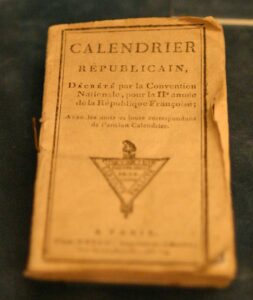
Revolutionary Calendar – By Rama – Self-photographed, CC BY-SA 2.0 fr, https://commons.wikimedia.org/w/index.php?curid=875464
They went to extreme efforts to eradicate any hint of religion in the French culture. The United States Constitution notes it was “done in the year of the Lord”; the French revolutionaries decided to restart the calendar without reference to the birth of Christ making 1792 the new “Year One.”
They did not want a seven day week associated with a Sabbath day of rest as this was associated with the Bible. They replaced the seven day week with a ten-day “decade” week with a ten-month year.
“French Revolutionary Time” divided the day into ten decimal hours with each hour consisting of 100 decimal minutes and each minute containing 100 decimal seconds. Every measure was to be divisible by ten, as ten was considered the number of a man as people have ten fingers.
The secular government proceeded to,
- Forbid crosses as being offensive,
- Religious monuments were destroyed,
- Statues were torn down, including that of Good King Henry IV,
- Christian graves were desecrated including that of the patron saint of Paris, St. Genevieve, who called the city to pray when Attila the Hun was attacking in 451 AD,
- Private and public worship and education was outlawed,
- Priests and ministers, including anybody harboring or protecting them, were executed on sight,
- Churches were closed or used for immoral behaviors. Robespierre put a prostitute in Notre Dame Cathedral, covered her with a sheet, and called her the “goddess of reason” to be worshiped.
The Cathedral of Our Lady at Strasbourg was turned into a Temple of Reason.

Voltair – By Nicolas de Largillière – This file has been extracted from another file: Nicolas de Largillière, François-Marie Arouet dit Voltaire (vers 1724-1725) -001.jpg, Public Domain, https://commons.wikimedia.org/w/index.php?curid=80206718
Yale University President Timothy Dwight gave a speech on Independence Day, 1798 tracing the origin of the revolutionaries. He noted,
About the year 1728, Voltaire, so celebrated for his wit and brilliancy and not less distinguished for his hatred of Christianity and his abandonment of principle formed a systematical design to destroy Christianity and to introduce in its stead a general diffusion of religion and atheism…
With great art and insidiousness, the doctrines of Christian theology were rendered absurd and ridiculous; and the mind of the reader was insensibly steeled against conviction and duty …
The overthrow of the religious orders in Catholic countries, a step essentially necessary to the destruction of the religion professed in those countries.
Voltaire’s plan was described,
The appropriation to themselves, and their disciples, of the places and honors of members of the French Academy. In this way they designed to hold out themselves to dictate all literary opinions to the nation.
The fabrication of books of all kinds against Christianity, especially such as excite doubt and generate contempt and derision.
The being of God was denied and ridiculed.
The possession of property was pronounced robbery.
Chastity and natural affection were declared to be nothing more than groundless prejudices.
Adultery, assassination, poisoning, and other crimes of the like infernal nature, were taught as lawful, provided the end was good.
The good ends proposed are the overthrow of religion, government, and human society, civil and domestic.
These they pronounce to be so good that murder, butchery, and war, however, extended and dreadful, are declared by them to be completely justifiable.
The Vendee Massacre

The Vendee region of France – By Marmelad – Own work based on: Départements de France-simple.svg:, CC BY-SA 2.5, https://commons.wikimedia.org/w/index.php?curid=2710825
Many religious French citizens were appalled by what was happening in Paris, especially the denigration of religion and the debasement of churches. Any such dissent was not tolerated by the central government which sent its army to the western French province called the Vendee.
Hundreds of thousands of religious citizens who refused the endorse the secular, anti-religious government were killed in what is considered to be the first modern genocide. Those living in the Vendee were ascribed by the central government to be an “impure race” and “slaves.” The military commanders were given the mandate to exterminate the entire population. Not just the young men or people actively resisting the central government were targeted, but all Vendeans including women, the elderly, and children.
The slaughter of a huge number of non-conforming religious Catholic French natives served as a model for future socialist mass exterminations. In fact, the terror tactics of Lenin’s Soviet government were explicitly modeled after the genocide at the Vendee. Lenin called the Russian victims of his mass slaughters “Vendeans,” and his diary referred to the mass drownings of peasants in the Russian Volga as his “Loire” – the region of France where the Vendee is located.
Sources now reveal it was an attempt to kill an entire people, their culture, and their ethnicity. Prefiguring the mass murders of Nazi Germany’s socialists, French military commanders explored ways to cut down the cost of their mass murder. This included poison gas, poisoned wells, mass drownings, and mass burning. For example, the children of the village of Petit-Luc were huddled into a local church which was then burned to the ground.
Solzhenitsyn – the Russian author who documented the horrors of a Russian gulag where he was imprisoned – saw the connection between the mass extermination of the Vendee by French socialists and modern socialist Russia under Lenin. The French Revolution and the Soviet Revolution a century later both were from atheist revolutionaries intent on remaking society for the “working masses.”
The French General Francois Joseph Westermann wrote back to the Committee of Public Safety his “success” at the mass slaughter of the Vendee,
There is no more Vendee. According to the orders that you gave me, I crushed the children under the feet of the horses, massacred the women who, at least for these, will not give birth to any more brigands. I do not have a prisoner to reproach me. I have exterminated all.
When he returned to Paris, he was accused and found guilty of supporting a revolutionary faction out of favor and was guillotined.
The extensive slaughter of defenseless citizens even bothered a young French officer named Napoleon, who pleaded poor health to escape participation in the slaughter.
French-American War during the French Revolution
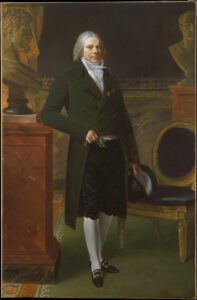
Talleyrand – By Pierre-Paul Prud’hon – Metropolitan Museum of Art, online collection (The Met object ID 110001788), Public Domain, Link
The revolutionary government in France no surprisingly ran into monetary difficulties. It is difficult to have a stable economy during a time of a revolution, especially when hundreds of thousands are being slaughtered in a genocide.
The government sent its navy into the Atlantic to seize ships from various countries in order to fund its activities. The French navy ignored various treated negotiated by the monarchy and by 1798 had seized nearly 300 American ships bound for British ports.
Talleyrand, the French Minister of Foreign Affairs, offered to stop seizing ships if the American government would pay a bribe of millions of dollars. While this apparently was a common practice in revolutionary France, the Americans refused. The XYZ affair was a political and diplomatic episode during the young presidency of John Adams where letters substitute for the names of French diplomats negotiating with the Americans.
An American diplomatic commission including Charles Pinkney, John Marshall, and Eldridge Gerry, was sent to negotiate some agreement; however, the commission left France without any formal agreements.
Most American citizens were outraged when the demands for a bribe were made public. The outcry “Millions for defense, not a cent for tribute” rang across the country.
America prepared for war with France. George Washington was called out of retirement in 1798 and accepted the commission as leader of the military. He noted,
Satisfied you have exhausted, to the last drop, the cup of reconciliation, we can, with our hearts, appeal to Heaven for the justice of our cause; and may confidently trust the final result to that kind Providence who has, heretofore, and so often, signally favored the people of these United States.
Felling how incumbent it is upon every person to contribute at all times to his country’s welfare, and especially in a moment like the present, when everything we hold dear and sacred is so seriously threatened.
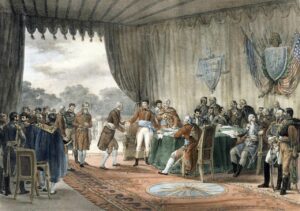
Convention of 1800 Signing – By Victor Adam – Unknown source, Public Domain, https://commons.wikimedia.org/w/index.php?curid=10587077
The failure of the commission led to the Quasi-War with France. The war was fought in the Caribbean consisting primarily of naval battles which were largely inconclusive. Talleyrand realized he had miscalculated the warlike attitude of the United States and further negotiators were sent by Adams in 1799. Eventually, the Convention of 1800 led to an end to the Quasi-War.
Result of the French Revolution – Napoleon
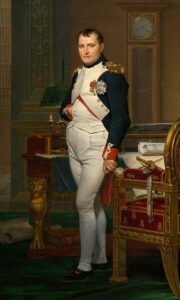
Napoleon – By Jacques-Louis David – zQEbF0AA9NhCXQ at Google Cultural Institute maximum zoom level, Public Domain, Link
The natural history of socialist states is the centralization of power away from the people and into fewer and fewer leaders. This history was repeated when revolutionary France fell into a dictatorship led to a series of wars that eventually destroyed France.
Napoleon was born in Corsica to a modest Italian family of nobility and was originally named Napoleone di Buonaparte. He served as an artillery officer in the French army when the French Revolution broke out in 1789 and rapidly rose through the rank of the military becoming a general at age 24.
He would go on to win nearly every military battle fought with other countries including Austria and Italy and became a war hero. In 1798, he led a military campaign into Egypt. Fresh from his successful war campaigns, Napoleon was a French hero. He cleverly deployed his troops around Paris and through a series of events, was able to establish himself as leader of France on November 9, 1799.
This effectively ended the French Revolution with many of the revolutionaries arrested and exiled. Napoleon would then lead his country into a series of wars throughout Europe leading to the slaughter of millions.
Summary of the French Revolution
The American Revolution and the French Revolution happened at about the same time in the latter part of the 18th century, but they had vastly different outcomes.
There was a real danger of war between France had the young United States over the seizure of American ships by the French. President Adams declared a Day of Fasting on Marcy 23, 1798, and again on March 6, 1799.
The people of the United States are still held in jeopardy by insidious acts of a foreign nation, as well as by the dissemination among them of those principles subversive to the foundations of all religious, moral, and social obligations.
I hereby recommend a Day of Solemn Humiliation, Fasting, and Prayer; that the citizens call to mind our numerous offenses against the Most High God, confess them before Him with the sincerest penitence, implore His pardoning mercy, through the Great Mediator and Redeemer, for our past transgressions, and that through the grace of His Holy Spirit, we may be disposed and enabled to yield a more suitable obedience to His righteous requisitions.
That He would interpose to arrest the progress of that impiety and licentiousness in principle and practice so offensive to Himself and so ruinous to making.
“Righteousness exalteth a nation but sin is a reproach to any people.”
On the other side of the ocean, France’s godless Revolution let loose a Reign of Terror that has only been matched by similar godless Revolutions of the last century. France’s Revolution would become the blueprint for subsequent socialist and communist revolutions. These revolutions believed that the total destruction of an old order was justified as a necessary transition to a promised utopian paradise – a Worker’s Paradise in Marxist jargon.
Ultimately, these Revolutions inspired by the French model resulted in totalitarian dictatorships such as those led by Napoleon, Hitler, Mao, Lenin, Stalin, Castro, Hugo Chavez, among many, many others.
Best selling author Os Guinness in a recent interview noted,
The culture war now at its deepest roots is actually a clash between 1776, what was the American Revolution, and 1789 and heirs of the French Revolution.
British Statesman Lord Acton wrote,
What the French took from the Americans was their theory of revolution, not their theory of government – the cutting, not their sewing.
President Adams’ leadership and call to prayer successfully led America away from a destructive war with France toward a religious revival. Where secular France turned its back on God, pulled down statues, engaged in violent riots throughout the country, burned down churches and pulled God out of their society, America experienced a religious revival called the Second Great Awakening and did just the opposite.
In contrast to the atheistic French Revolution, religious enthusiasm spread throughout America which led to a revolutionary atmosphere all its own. The Revival gave birth to organizations which promoted,
- hospitals,
- prison reform,
- care for the handicapped and mentally ill,
- YMCA chapters,
- the abolitionist movement to end slavery.
- the Civil Rights movement
Fyodor Dostoevsky – Without God, Everything Is Permissable
The restraining influence of theism upon the outbreak of tyranny has been known for many years, even among despots. Socialism and Communism are both paths to atheism. Lenin noted that atheist convictions are necessary for a socialist society. History shows that a strong central government tends toward consolidation of further power often at the expense of the citizens it is supposed to serve. This tendency is now being re-enacted in China where there is an all-out war against religious belief of any kind.
Perhaps the best expression of the tendency of atheist government to become tyrannical was expressed by Fyodor Dostoevsky who opined that without a belief in God and the restraining influence of such belief, all things are lawful,
And Rakitin does dislike God. Ough! doesn’t he dislike Him! That’s the sore point with all of them. But they conceal it. They tell lies. They pretend. ‘Will you preach this in your reviews?’ I asked him. ‘Oh, well, if I did it openly, they won’t let it through,’ he said. He laughed. ‘But what will become of men then?’ I asked him, ‘without God and immortal life? All things are lawful then, they can do what they like?’ ‘Didn’t you know?’ he said laughing, ‘a clever man can do what he likes,’ he said. ‘A clever man knows his way about, but you’ve put your foot in it, committing a murder, and now you are rotting in prison.’ He says that to my face! A regular pig! I used to kick such people out, but now I listen to them. (The Brothers Karamazov)
Is it just a coincidence that the increasingly secular anti-religious American society is now suffering riots, looting, intolerance, and burning of family businesses and churches? This activity is justified as being necessary for a “total transformation” of America. The lessons of the past frequently have to be relearned in the future; the future may be now.
References:
https://www.sparknotes.com/history/european/frenchrev/section2/page/2/
https://newsmaven.io/americanminute/american-history/french-revolution-bastille-day-reign-of-terror-libert%C3%A9-%C3%A9galit%C3%A9-fraternit%C3%A9-RS1lyByXx0-DAPkUKXdNhw

